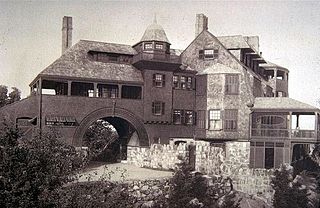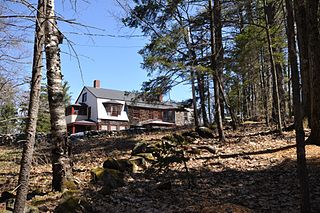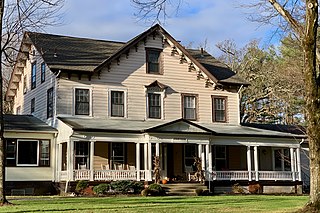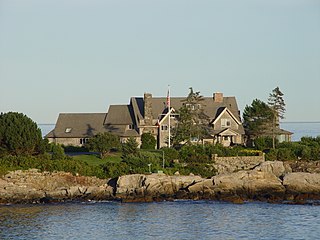
Jefferson is a town in Coos County, New Hampshire, United States. The population was 1,107 at the 2010 census. It is home to parts of the White Mountain National Forest in the south and northeast and to Santa's Village, a Christmas-themed amusement park. There are also several private campgrounds, motels and inns.

The Bellevue Avenue Historic District is located along and around Bellevue Avenue in Newport, Rhode Island, United States. Its property is almost exclusively residential, including many of the Gilded Age mansions built by affluent summer vacationers in the city around the turn of the 20th century, including the Vanderbilt family and Astor family. Many of the homes represent pioneering work in the architectural styles of the time by major American architects.

The Shingle style is an American architectural style made popular by the rise of the New England school of architecture, which eschewed the highly ornamented patterns of the Eastlake style in Queen Anne architecture. In the shingle style, English influence was combined with the renewed interest in Colonial American architecture which followed the 1876 celebration of the Centennial. The plain, shingled surfaces of colonial buildings were adopted, and their massing emulated.

The West Chop Club Historic District is a historic district in Tisbury, Massachusetts, on the island of Martha's Vineyard. The district represents a well-preserved planned summer resort community of the late 19th century. Located in and around Iroquois Avenue, the district encompasses the northernmost portion of West Chop, a peninsula that separates Vineyard Sound and the sheltered waters of Vineyard Haven Harbor, an area that was developed by the West Chop Land Company in the 1880s. The land is now owned by the West Chop Land Trust and managed by the private West Chop Club. The district was listed on the National Register of Historic Places in 2007.

The Wianno Historic District is a historic district in the Osterville section of Barnstable, Massachusetts. It encompasses a well-preserved summer resort area for the wealthy that was first developed in the late 19th century, focused around the Wianno Club, built in 1881 on the site of an earlier resort hotel. The 40-acre (16 ha) district has a significant number of well-preserved Shingle style and Colonial Revival houses. Architect Horace Frazer designed the Wianno Club, as well as a number of the private residences in the district. The district is roughly bounded by East Bay Road, Wianno and Sea View Avenues between Nantucket Sound and Crystal Lake. It was added to the National Register of Historic Places in 1987.

The Wianno Club is a historic club at 107 Sea View Avenue in Osterville, Massachusetts. The club began as the Cotocheset House, a Shingle-style structure built in 1882 on the site of a grander hotel that burned down in 1881. This hotel was the centerpiece of a major resort development for the wealthy that was mostly developed prior to World War I. In 1916 the newly founded club purchased the hotel property. The club built a nine-hole golf course on the original land purchase now occupied by holes numbered 13-18. The 16th was the first hole, and the Swan residence behind the hole was built as the original clubhouse. Additional land was assembled on the west side of Parker Road and north of West Bay Road and in 1919, Donald Ross was hired to redesign the original nine and to create a new nine.

The Glen Road Historic District is a historic district at 233-317 Glen Road in Weston, Massachusetts. The district encapsulates historical development trends in Weston, in which land began in agricultural uses, and was later transformed into either resort or suburban residential housing. It is also notable for its longtime association with the Jennings family, who owned the land from the 18th century into the 20th, and engaged in all three land uses. The district was listed on the National Register of Historic Places in 2006.

The Mary Anne Wales House, also known as The Briar-Patch, is a historic house on Snow Hill Road in Dublin, New Hampshire. Built in 1886, it is a well-preserved local example of the Shingle style, and an early residence of the town's late 19th-century summer resort colony. The house was listed on the National Register of Historic Places in 1983.

Schooley's Mountain Historic District is a historic district along Schooley's Mountain, Pleasant Grove, and Flocktown Roads, and Heath Lane in the Schooley's Mountain section of Washington Township, Morris County, New Jersey. It was added to the National Register of Historic Places on June 14, 1991 for its significance in architecture, entertainment/recreation, and health/medicine. The district includes 71 contributing buildings, such as the Oak Cottage, site of schoolhouse No. 5, Schooley's Mountain Store, the William W. Marsh House, Christadelphian Bible Camp, the former Heath House Hotel, former Forest Grove Hydropathic Institute, Mine Hill Farm, the Marsh Mine and several private residences and commercial buildings.

Thousand Island Park Historic District is a national historic district located on the south tip of Wellesley Island at Orleans in Jefferson County, New York, United States. The district includes 294 contributing buildings. It is an outstanding concentration of substantially intact late 19th century and early 20th century resort architecture. It was listed on the National Register of Historic Places in 1982.

The Spring–Douglas Historic District is a set of 496 buildings in Elgin, Illinois. Of those, 455 buildings contribute to the district's historical value. It is a residential district following Spring Street and Douglas Avenue from Kimball Street in the south to River Bluff Road to the north. The lands that now comprise the district were originally settled by Phineas J. Kimball and Vincent Lovell in the 1830s. Kimball's property eventually became the southern part of the district, which mostly housed working-class citizens. Lovell's subdivisions became housing for wealthier managers and doctors. The lower district is noted for its vernacular architecture, mostly gablefront houses, while the upper district represents a wide array of late 19th and early 20th century styles, mostly Queen Anne.

Knollwood is an historic summer estate house on Windmill Hill Road in Dublin, New Hampshire. The large 2 1/2 story "summer cottage" was designed by Shepley, Rutan and Coolidge and built in 1899-1900 for banker Franklin MacVeagh. One of Dublin's major summer estate houses, it was listed on the National Register of Historic Places in 1983.

The McKenna Cottage is a historic house on Windmill Hill Road in Dublin, New Hampshire. It was originally built about 1889 as a single-story wing of the nearby Stonehenge estate house. It is a good example of Shingle style architecture, and one of the town's surviving reminders of the turn-of-the-century summer estate period. The house was listed on the National Register of Historic Places in 1983.

The Abenaki Indian Shop and Camp is a historic Native American site in the Intervale section of Conway, New Hampshire. The site is a camp established by Abenakis who were lured to the area by the prospect of making baskets and selling them to visitors to the resort areas of the White Mountains in the late 19th century, and operated into the late 20th century. The site was listed on the National Register of Historic Places in 1991, and has also been listed on the New Hampshire State Register of Historic Places. It is located on Intervale Cross Road, about one mile east of New Hampshire Route 16, and is now a local public park.

The Chocorua Lake Basin Historic District is a large historic district surrounding Chocorua Lake in the town of Tamworth, New Hampshire. It includes more than 6,000 acres (2,400 ha), with the lake roughly at its center, extending from Washington Hill Road in the east to Fowles Mill Road and Philbrick Neighborhood Road in the west, and from the town line with Albany in the north to Heavenly Hill Road in the south. The district's significance derives from a large cluster of late 19th and early 20th century summer resort houses built around and near the lake, and the role the area's landowners have played in the conservation of the lake and viewsheds associated with it and nearby Mount Chocorua. The district was listed on the National Register of Historic Places in 2005.

Manor and Cottages is a historic resort complex and national historic district located at Asheville, Buncombe County, North Carolina. The complex encompassed 36 contributing buildings that were built starting in 1898. The main hotel, The Manor, was built starting in 1898–1899, and consists of a rambling group of interconnected wings with elements of the Colonial Revival, Shingle Style, and Tudor Revival styles. Wings were added to the original building in 1903 and 1913–1914. Located on the property are the contributing Club House and a 19 guest cottages built between 1899 and 1920. The hotel was later converted for use as a retirement hotel for elderly persons with limited incomes.

The Kineo Cottage Row Historic District encompasses a collection of seven summer resort cottages on the Mount Kineo peninsula, which juts into Moosehead Lake in the central Maine. The cottages were built between 1900 and 1912 as part of the Mount Kineo resort complex, one of interior Maine's most successful summer resorts of the early 20th century, and are its only major surviving component. The cottages were listed on the National Register of Historic Places in 2004.

The Cape Arundel Summer Colony Historic District encompasses an enclave of large summer estates on the coast of Kennebunkport, Maine. The area was developed in the late 19th and early 20th century as a resort area for the wealthy of the northeastern United States. It notably includes the Kennebunk River Club and Walkers Point, the location of the Bush compound, which has a Shingle-style house built in 1903. The district was listed on the National Register of Historic Places in 1984.

The Colonial Inn is a historic hotel at 145 Shore Road in Ogunquit, Maine. The hotel complex is anchored by an 1890 Queen Anne Victorian hotel that is one of the few surviving resort hotels of the period, and is listed on the National Register of Historic Places. The complex also has rooms in adjacent motel spaces; its amenities include a swimming pool, game room, and dining room serving breakfast.

The Morris Cove Historic District encompasses a former summer resort area in eastern New Haven, Connecticut. Bounded in the north by Myron Street, the south by Morris Causeway and Lighthouse Road, and on the east by the East Haven town line, the area was developed as a coastal summer community before being transformed into a streetcar suburb in the second quarter of the 20th century. It contains a high concentration of quality residential architecture from the first half of the century, and was listed on the National Register of Historic Places in 1985.
























